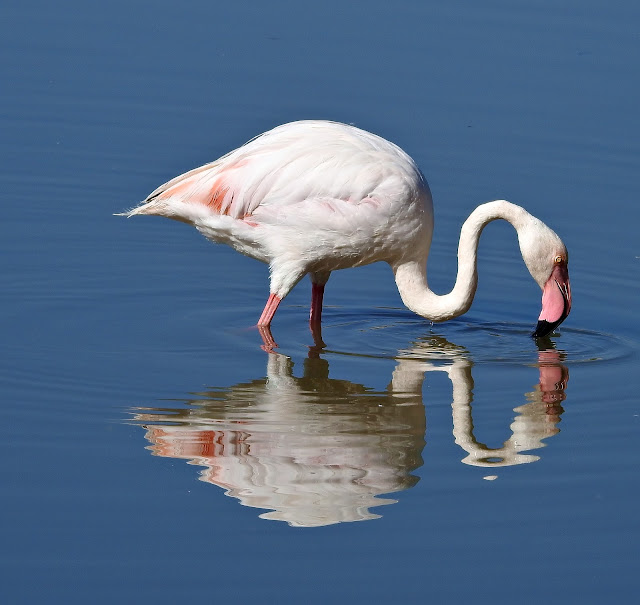The greater flamingo is the largest living species of flamingo, averaging 110–150 cm (43–59 in) tall and weighing 2–4 kg (4.4–8.8 lb). The largest male flamingos have been recorded to be up to 187 cm (74 in) tall and to weigh 4.5 kg (9.9 lb).
Most of the plumage is pinkish-white, but the wing coverts are red and the primary and secondary flight feathers are black. The bill is pink with a restricted black tip, and the legs are entirely pink. The call is a goose-like honking.
Chicks are covered in gray fluffy down. Subadult flamingos are paler with dark legs. Adults feeding chicks also become paler, but retain the bright pink legs. The coloration comes from the carotenoid pigments in the organisms that live in their feeding grounds. Secretions of the uropygial gland also contain carotenoids. During the breeding season, greater flamingos increase the frequency of their spreading uropygial secretions over their feathers and thereby enhance their color. This cosmetic use of uropygial secretions has been described as applying "make-up".

It is found in parts of Northern Africa (including coastal areas of northern Algeria, Egypt further inland along the Nile River, Libya, Morocco, and Tunisia), portions of Sub-Saharan Africa (Kenya, Madagascar, Rwanda, Tanzania, Uganda), Southern Asia (coastal Bangladesh, Pakistan, India, and Sri Lanka), the Middle East (Bahrain, Cyprus, Iraq, Iran, Oman, Israel, Kuwait, Lebanon, Qatar, and the United Arab Emirates) and Southern Europe (including Albania, Bulgaria, Corsica, Croatia, France in the Camargue, Greece, Italy, Slovenia, Malta, Monaco, Montenegro, North Macedonia, Portugal, Spain and the Balearic Islands, and Turkey. The most northern breeding spot is the Zwillbrocker Venn in western Germany, close to the border with the Netherlands. They have been recorded breeding in the United Arab Emirates at three different locations in the Abu Dhabi Emirate. In Gujarat, a coastal state in the west of India, flamingos can be observed at the Nal Sarovar Bird Sanctuary, Khijadiya Bird Sanctuary, Flamingo City, and in the Thol Bird Sanctuary. They remain there during the entire winter season.

The greater flamingo resides in mudflats and shallow coastal lagoons with salt water. Using its feet, the bird stirs up the mud, then sucks water through its bill and filters out small shrimp, seeds, blue-green algae, microscopic organisms, and mollusks. The greater flamingo feeds with its head down, its upper jaw movable and not rigidly fixed to its skull.
Like all flamingos, this species lays a single chalky-white egg on a mud mound.
The typical lifespan in captivity, according to Basel Zoo, is over 60 years. In the wild, the average lifespan is 30 – 40 years.
Adult greater flamingos have few natural predators. Eggs and chicks may be eaten by raptors, crows, gulls, and the marabou stork (Leptoptilos crumenifer); an estimated half of the predation of greater flamingo eggs and chicks is from the yellow-legged gull (Larus michahellis).














%201.jpg)
%202.jpg)
%204.jpg)


















%201.jpg)


%201.jpg)

%201.jpg)
%202.jpg)




%201.jpg)
%202.jpg)